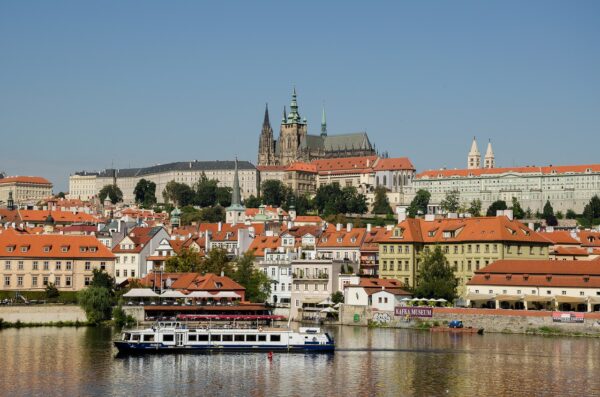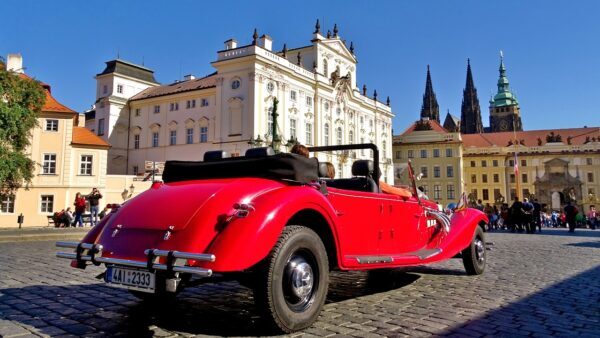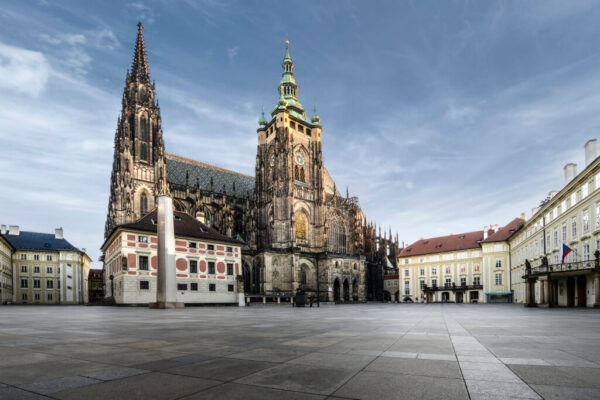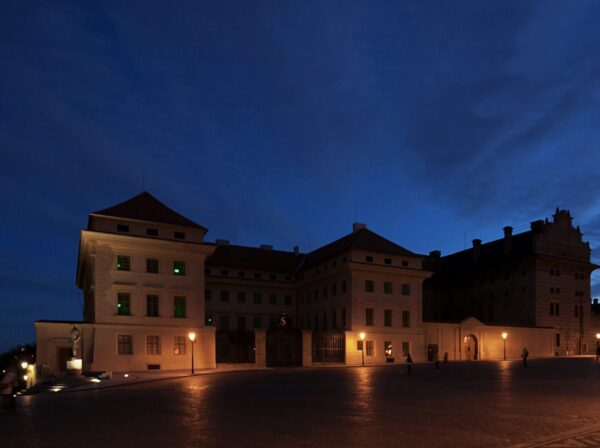Hradčany hill
Hradčany hill is the historic birthplace of this mesmerizing place. It is the hill where we find the vast Prague Castle complex, the Pražský Hrad (Prague Castle) or just Hrad, located in Hradcany (Castle district), a hill above the west bank of the Vltava River.
By the beginning of the 9th century, a settlement with the name of Praha (práh translates into threshold in English) occupied about two-thirds of the hilltop later taken by Prague Castle, packed with timber structures & wooden buildings.


The first masonry on the site of the castle appears around 885 with its first walled building being that of the Church of the Virgin Mary, built by Prince Borivoj I, founder of the Premyslid dynasty who ruled Bohemia for hundreds of years. The castle built around the church became Prince Borivoj‘s seat and the surrounding city didn’t take long to evolve. For about 13 centuries the castle was built, rebuilt, expanded, and renovated.
Today the largest coherent castle complex in the world, with an area of almost 70,000 m² is a UNESCO World Heritage site, where Romanesque style (Old Royal Palace) meets Gothic (St. Vitus Cathedral), Italian Renaissance style (Royal Palace & Queen Anne’s Summer Palace), Baroque (Matthias Gate & Lobkowicz Palace) and Rococo (Archbishop’s Palace).
This World Guinness Record Winner of a castle has so many points of uppermost interest that covering all of them in just one day is almost impossible.


To enter Prague Castle one must first reach one of its most prominent squares. Hradcany square or Hradcanské námestí is the main access point to the castle. At its eastern side, the impressive main entrance gate is guarded by the two enormous sculptures of fighting giants that stand above the two flesh and arm members of the Castle guard. At its center, a column surrounded at its base by statues of saints and topped by one of the virgin Mary commemorates the end of the last outbreak of the plague in the city in 1713-1714. The square is surrounded by a series of striking & impeccably preserved palaces.


On the right side of the square as we face the castle gates, lies one of the finest examples of Early Renaissance buildings in Prague, the Schwarzenberg Palace (Schwarzenberský palác). Its amazing black and white sgraffito (a technique in which wet plaster is scraped away to create distinctive patterns) decorations on the exterior walls can easily fool the eyes & make you believe that the palace is built on evenly placed & pyramid shaped stones.
Designed by an Italian master builder for one of the richest noblemen in Bohemia of the mid-16th century, the palace changed masters several times until a family of Bavarian nobles, the Schwarzenberg took it into its possession in 1719.
In the 20th century the palace passed to the Bohemian state and was turned first into a Technical Museum, then a Museum of Military History, and finally in 2007 it became a department of the National Gallery. In its interior, the original frescoes created back in 1580 cover the ceilings with famous scenes from antique mythology, like “The Kidnap of Helen” & “The Conquer of Troy”.


On the very top floor, the museum houses a superb collection of weaponry that spans from the Middle Ages to the 19th century, while its basement is dedicated to a collection of jewelry, precious cutlery, and tableware from medieval times.
The rest of the exhibition covers late Renaissance and Baroque art from Bohemia, both sculptures and paintings. Being next door to the castle complex this museum is usually neglected by the tourists making it a pleasant hideaway from all the hustle and bustle outside.


Right next to Schwarzenberg Palace is the classicist three-winged Salm Palace (Salmovský palác). The palace started taking its form after the integration of two pre-existing Renaissance Palaces in 1648. In 1810 Prague’s Archbishop & Prince Vilém Florentin gave the property its current appearance which is visibly influenced by the Imperial style.
This property also passed to the Schwanzerberg family before it was nationalized after WWII. Today it is also under the administration of the National Gallery which uses since 2008 to house a permanent exhibition of the most important examples of Czech painting and sculpture in the period from neoclassicism to romanticism. The spaces on the ground floor of the Salm Palace are designed for temporary exhibitions.



